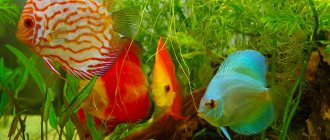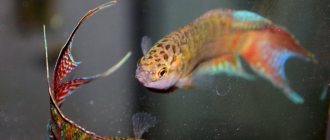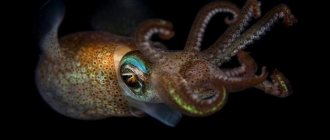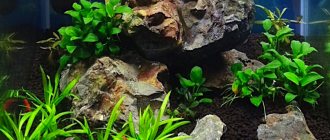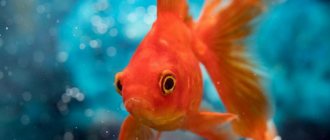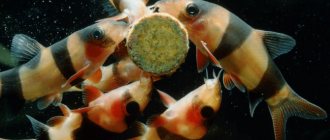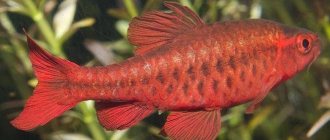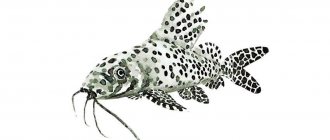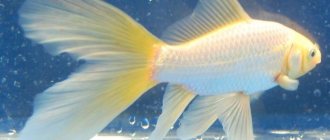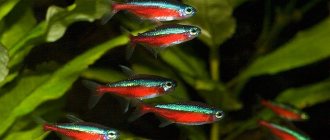Angelfish (lat. Pterophyllum scalare) is a genus of fish of the cichlid family (Cichlidae). They are one of the most popular and most widely distributed aquarium fish. It is a large, voracious fish that likes to eat fry and shrimp, although it is quite beautiful and has interesting behavior. Its tall and laterally flattened body, quite varied color and large size - all this made the angelfish one of the most common and popular fish among aquarists.
History and classification of angelfish
The name of the genus Pterophyllum was given by the Austrian zoologist Johann Jakob Haeckel (23 January 1790 – 1 March 1857) in 1840. It comes from the Greek words πτερος - “wing”, and φυλλον - “leaf” and literally means “winged leaf”.
But even before Haeckel, the scalar was described by two zoologists: Martin Heinrich Karl Lichtenstein (1780-1857) and Georges Cuvier (1769 - 1832) in 1823 and 1839, respectively, who gave it the specific name scalaris, but did not definitively determine the genus that needed clarification.
Haeckel is also credited with introducing the angelfish into a new, separate, single-species genus, Pterophyllum scalaris. After the revision in 1862, the generic name remained the same, but the ending in the species name, in accordance with the rules of the Latin language, was changed from "scalaris" to "scalare".
Later, two more species were added to it - Pterophyllum leopoldi and Pterophyllum altum. But scientists did not stop there; work in this direction continues to this day; according to some ichthyologists, the genus should consist of more species.
In English the fish is called “angelfish” - angel fish, for its high fins, in German the fish is “Segelflosser” (from the word “segel” - sail), in Spanish Peces ángel or Escalares.
The fish were first introduced to the general public in 1911 and were developed in Germany in 1914, on the eve of the First World War. In those days they were very expensive, and the method of their breeding was kept in the strictest confidence. And only a few years later, many Western aquarists of that time mastered its breeding.
Having mastered the breeding method, many aquarists did not stop there, starting work on selection. Since the growing popularity of fish every year required new shapes and colors.
Breeding work with angelfish has become so large-scale that today the numerous color forms of this species are taken for granted by everyone.
Types of angelfish
There are currently three species in the genus: Pterophyllum scalare, Pterophyllum altum and Pterophyllum leopoldi. At the moment, it is quite difficult to understand which species is now the most common in the aquarium hobby, since crossing has played a role.
Altum angelfish (Pterophyllum altum)
Pterophyllum altum or angelfish altum (Pellegrin, 1903). It is found strictly in the Orinoco River basin and the upper Rio Negro watershed in southern Venezuela, southeastern Colombia and the far north of Brazil. This species is the largest representative of its genus, and specimens can be up to 38 cm in height (from the tip of the dorsal fin to the tip of the anal fin).
Also characteristic is a sharp transition between the forehead and mouth, forming a depression. There are red dots on the fins.
For many years this species could not be bred in captivity, but in recent years it has been possible to obtain altum fry and in many countries they are bred for sale.
Pterophyllum scalare or common angelfish (Lichtenstein, 1823), habitat: large and small rivers of the Amazon basin (in Peru, Colombia and Brazil). This is the most common species in the aquarium trade.
Leopold angelfish (Pterophyllum leopoldi)
Pterophyllum leopoldi or Leopold's angelfish (JP Gosse, 1963), habitat: Amazon River basin (between Manakapuru and Santarem), Essequibo River and Rupununi River. It differs from other representatives of the genus Pterophyllum by the presence of a black spot at the base of the dorsal fin on the 4th vertical ray. There are a couple of black stripes on the body, and one on the dorsal fin, but not extending onto the body. Significantly different in head shape.
Rarely found, very similar to the common angelfish.
Angelfish (Pterophyllum scalare)
Probably the majority of angelfish sold today belong to this species. Traditionally considered the most unpretentious and easy to breed.
Living in the wild
Angelfish is a freshwater tropical fish. The fish prefers slow-moving waters in South America: in the central basin of the Amazon River and its tributaries in Peru, Brazil and Colombia. In particular, the Ucayali River in Peru, the Oyapoc River in French Guiana, the Essequibo River in Guyana, the Solimões, Amapá and Amazon Rivers in Brazil. It is found in swamps or flooded lands where the vegetation is dense and the water is clear or cloudy. Water parameters vary from pH 6.0 to 7.0, water hardness from 3 to 10 °dH, and water temperature ranges from 26 to 30 °C.
In the wild, the fish live in densely planted areas where they feed on juvenile fish, insects, invertebrates and plants. They prefer ponds and rivers with slow flows and dense vegetation. The reservoirs in which angelfish live are characterized by warm, soft and slightly acidic water.
The flattened shape of the body allows them to easily maneuver among thickets of underwater plants, and the vertical dark stripes make them less noticeable to predators. In nature, fish usually gather in small schools.
Description
Fish that live in nature have a silvery body with dark stripes. Laterally compressed body, with large fins and a pointed head. Long thin rays may develop on the caudal fin of mature fish. This shape helps them camouflage among roots and plants. This is why the wild form has a coloring in the form of vertical dark stripes.
Adult fish reach 15 cm in length and up to 25 cm in height. The average lifespan of an angelfish is 10 years, but there are cases when they lived 15 years or more.
However, describing the angelfish that are currently on sale is quite a difficult task. As a result of the breeding work of amateurs, a huge number of color variations were obtained - from golden to black angelfish. Today, the most popular are combinations of two or more colors (for example, koi angelfish or red devil angelfish) or unusual colors (blue angel angelfish, Pinoy angelfish).
Below is a photo of an angelfish, but this is only a small part of the variety that can be found in amateur aquariums.
Diet
Angelfish are omnivores. The basis of their diet should consist of live food, such as bloodworms, coretra, tubifex, daphnia. It is advisable to feed them twice a day, based on 10-15 average bloodworms per adult. They also enjoy eating dry food in the form of flakes and granules. Hungry angelfish can eat fry and young of other small fish species. Adding plant-based food to the diet helps maintain bright colors and good health of fish. Many varieties of lettuce and spinach can be used as such feeding. Thinly sliced young zucchini is an excellent plant food. Before use, all these products should be doused with boiling water and blanched, then cooled, and only then offered as food to fish. In addition, dry food from different manufacturers is available for sale, containing components of plant origin.
The best starter food for angelfish fry is brine shrimp nauplii, while commercially available frozen brine shrimp are good for keeping adult fish in good condition. It is worth considering that the exoskeletons of artemia and daphnia break when frozen and their nutritional value decreases after thawing. The larvae of the bell mosquito, the thick proboscis mosquito and krill tolerate freezing better and are the most preferred. Ground beef can also be used as angelfish , but feeding it continuously can degrade water quality.
for angelfish to lift food from the bottom, so special feeders should be used. Sometimes, for no apparent reason, angelfish refuse to take food; this situation can last up to a week, after which they start eating again as if nothing had happened.
Difficulty in content
Of average complexity, but not recommended for beginner aquarists, as they require decent volumes, stable water parameters and can be aggressive towards small fish. In addition, they hunt fry and small shrimp with remarkable dexterity. If there is a lack of experience in keeping them, they die or actively eat other fish, causing negative feelings in the novice aquarist.
They themselves may also suffer from fish that break off their fins, such as Sumatran barbs and thorns.
Keeping in an aquarium
The fish are fairly undemanding and have a lifespan of over 10 years if they have the right conditions. It is better to keep it in a group of 6-10 individuals. There is a certain hierarchy in a school of fish - larger specimens occupy the best places in the aquarium, but at the same time you can safely add younger fish to the school. As practice shows, adult angelfish treat them calmly. In general, the more individuals in a flock, the less intraspecific aggression. If there are 10 or more fish in a group, the attention of dominant individuals will be scattered, and the pursuit of weak ones will be minimized.
Despite their peaceful nature, they are capable of showing aggression towards small fish species, perceiving them as potential prey.
Aquarium volume
Due to their shape, tall aquariums with a volume of at least 120 liters are preferred. However, if you are going to keep several of these beautiful fish, it is better to get an aquarium of 250 liters or more. Another benefit of buying a spacious aquarium is that it makes parents feel calmer and does not eat their eggs as often.
Also, it is a tall fish and you need a fairly tall tank to keep it. The minimum is an aquarium with a water column height of 40 cm.
Aquarium setup
By nature they are very shy fish. Sudden movements near the aquarium, turning electric lights on and off, as well as loud noises can frighten the fish; the reaction to this can be sudden throws in different directions, as a result of which the fish are injured by hitting the decorations and walls of the aquarium.
The decor in the aquarium can be anything, but preferably without sharp edges that could injure the fish.
Plants and angelfish
Despite the fact that most sources indicate that angelfish are completely compatible with aquarium plants, this is not the case. Adult fish happily pull out fast-growing plants with a weak root system (for example, hemianthus micranthemoides and needle-shaped sycamore) from the ground. If this happens, add some fish food containing spirulina to your diet.
And they defeated their attempt to attach moss to a snag very easily. Regularly plucking Java moss one branch at a time. It’s difficult to say why they behave this way, but, apparently, out of boredom and a voracious appetite.
In an aquarium with freshwater angelfish, you need to keep plants that have a strong root system, for example Echinodorus. It is advisable to plant plants with wide leaves in the aquarium, such as nymphs or Amazons; they like to lay eggs on such leaves.
The preferred daylight hours are from 8 to 12 hours.
Water parameters
In the wild, the fish lives in slightly acidic and fairly soft water, but nowadays it adapts quite well to any conditions. Today they are no longer as capricious as before, and are able to live in a wide range of temperatures and water chemistry.
Let me remind you that this is a freshwater tropical fish and water temperature is very important. The optimal water parameters for keeping angelfish are the following: water temperature from 26 to 30°C (75 to 86°F), hardness from 3 to 10°dH, pH 6.0 - 7.0. Nitrate levels should be kept below 100 mg/L.
Fish are able to tolerate a short-term drop in water temperature to 18-20°C, but do not abuse it.
Filtration
The body structure of the angelfish is not adapted to swimming in strong currents, and filtration in the aquarium should be moderate. A large flow of water causes stress and slows down the growth of fish as they spend energy fighting it. You can often see how a flock takes refuge from the flow of water from the filter, hiding behind snags, bushes or swimming into a corner.
It is wise to use an external filter and supply water through a flute or an internal one and spray the flow.
Weekly water changes are required, about 20% of the volume. Angelfish are very sensitive to the accumulation of nitrates and ammonia in water. This is one of those fish that likes fresh water and plenty of changes. Many breeders practice 50% water changes in the aquarium, and if they are breeding or raising fry, this becomes a daily procedure.
Review Reviews
On the global network you can find many reviews dedicated to the maintenance and care of angelfish in home aquariums.
Most owners note the obvious advantages of these fish: beauty, original appearance, unpretentiousness, and a tendency to grow quickly.
The disadvantages, in turn, include aquarists: difficulties in breeding fish, their gluttony, difficulties in keeping them together with some representatives of the aquarium fauna.
They note that an aquarium with angelfish is a worthy decoration for the home. Despite their exotic origin, the fish are unpretentious in maintenance and care, do not require any specific conditions, grow quickly, and do not create problems for each other. Angelfish are practically omnivorous: they happily consume live and dry food, algae, and vitamin supplements.
Other owners were captivated by angelfish with their beauty and grace: you can watch them for hours. Unlike many lively fish that strive to jump out of the aquarium, angelfish are phlegmatic, swimming measuredly in the water column among the algae - this is very calming. The only problem was their breeding. As it turns out, this task can be difficult for an inexperienced person to complete.
In addition, aquarists note that there are specific nuances in keeping angelfish. Although these fish are considered peaceful, they sometimes conflict with other small inhabitants of the aquarium and can injure them. Due to these characteristics of these beautiful predators, snails and guppies may suffer. Experienced aquarists recommend placing angelfish in the same “house” only with proportionate inhabitants such as mollies and platies; they do not offend them.
To find out what types of angelfish there are and how to care for them, see the following video.
BEAUTIFUL PHOTOS OF AQUARIUM FISH - SCALARIA.
SCALARIA DISEASES: TREATMENT, SYMPTOMS, PHOTO, VIDEO, PREVENTION.
GOLDEN SCALARIA DESCRIPTION, BREEDING, COMPATIBILITY, CONTENTS, PHOTO.
SCALARIA ZEBRA DESCRIPTION, PHOTO, VIDEO.
BLACK ANCALARIA DESCRIPTION, BREEDING, CONTENTS, COMPATIBILITY, PHOTO.
SCALARIA MANAKAPURU DESCRIPTION, BREEDING, CONTENTS, PHOTO, VIDEO.
LEOPOLD'S SCALAR DESCRIPTION, CONTENTS, COMPATIBILITY, PHOTO, VIDEO.
SCALARIA ALTUM CONTENTS DESCRIPTION PHOTO REPRODUCTION
SCALARY GREEN ANGEL DESCRIPTION REPRODUCTION PHOTO CONTENTS
SCALARIA VEIL CONTENTS AND DESCRIPTION PHOTOS BREEDING COMPATIBILITY
BLUE ENGLISH DESCRIPTION PHOTO CARE
MARBLE SCALARIAN DESCRIPTION PHOTO CARE
Feeding
Fish prefer to feed on the surface of the water, but without any problems they take food in the middle layers of the aquarium and lift it from the bottom.
What to feed? Angelfish are omnivores; they eat any type of food in an aquarium: live, frozen and artificial.
The basis of feeding can be high-quality flakes, and additionally give live and frozen food: tubifex, bloodworms, brine shrimp, and coretra. It is important to know two things, they are gluttons and cannot be overfed, no matter how much they ask.
And give bloodworms very carefully, and it is better to refuse it altogether. A slight overfeeding of bloodworms, and their intestines begin to bloat, so much so that pink bubbles stick out from the anal bladder.
It is much safer to feed with artificial food, since it is now of high quality.
Aquarium propagation
Preparation for spawning consists of setting the temperature to +27...+32 °C, regular fluid changes, filtration, and aeration. Fish require enough space, at least 100 liters for a pair, shelter, and up to 10 hours of daylight.
They reach sexual maturity at 6-12 months and look for a mate on their own. After its formation, the male and female stay together, guard their chosen place, drive away neighbors, and the female cleans it. Its intention to spawn is determined by the increase in the size of its abdomen.
The female lays eggs on large leaves and pieces of driftwood. After this, the male fertilizes her, showering her with milk. In this case, 700-800 eggs are formed. Then the couple takes care of them, fans them, and eats the unfertilized ones (they turn white). The larvae hatch after three days, but still remain on the surface and feed on the contents of the yolk sac. After 7-12 days the fry are already swimming. They are fed with ciliates, cyclops, small bloodworms, and brine shrimp.
Often, owners select eggs and raise future fish in an incubator.
Read more in the article about breeding angelfish.
Compatibility
Angelfish can be kept in a community aquarium, but you need to remember that it is still a cichlid, and it can be somewhat aggressive towards small fish. The same goes for fry and shrimp, they are magnificent and insatiable hunters; in my aquarium they wiped out countless hordes of cherry shrimp.
Who can keep cichlids with? With large and medium-sized fish, it is advisable to avoid very small ones, such as cardinals and microrasbor galaxies, although for me they live wonderfully with neons. The most interesting thing is that others greedily eat these same neons. Apparently the size of the fish matters. If they can swallow it, they will certainly do it.
You definitely need to avoid barbs and preferably any barbs other than cherry ones. In my practice, a flock of Sumatran barbs did not touch them at all, but a flock of fire barbs almost destroyed their fins within a day. Although you think it should be the other way around. Fins can also be gnawed by thornets, tetragonopterus, black barb, Schubert barb and denison.
You can keep them with viviparous animals: swordtails, platies, mollies, even with guppies, but keep in mind that in this case you should not count on fry. Also marble gourami, pearl gourami, moon gourami, congo gourami, erythrozonus and many other fish.
Is it possible to keep angelfish and goldfish together? Keeping these fish together is a mistake. Goldfish need cooler water, and angelfish need cleaner water (goldfish are constantly digging in the ground and picking up waste). I don't recommend keeping them together.
Often these fish are placed in an aquarium with discus fish, which is also not entirely correct, since the high temperature in aquariums with discus fish differs from the most comfortable temperature for angelfish.
Adviсe
Experienced aquarists advise when choosing an aquarium to give preference to high tanks (at least 45 centimeters in height). Considering that the body of these fish is more elongated vertically than horizontally, they will be more comfortable in high rather than low tanks.
When arranging an aquarium, attention should be paid to ensuring that the fish have the opportunity to move freely in space. For these purposes, it is recommended not to clutter the central part of the tank with decorative items.
When keeping angelfish, it is worth considering that sometimes these cute creatures may refuse to eat for no reason. Their period of “fasting” can take from several days to 2 weeks. This behavior, according to experienced aquarists, is normal for these fish.
Taking into account the fact that angelfish are divided into pairs during the mating season, they should initially be purchased in a flock containing an even number of individuals. This approach will ensure that not a single fish is left alone.
Sex differences
How to determine gender? It is impossible to distinguish between males and females before the onset of sexual maturity. And even then, it can only be reliably understood during spawning, when the female develops a thick, cone-shaped ovipositor.
Indirect signs are deceptive, the male is lobbier and larger, especially since females can create a pair if there are no males. And this pair will behave in exactly the same way, right down to imitation of spawning. So you can only determine the sex of adult fish, and even then with some relativity.
